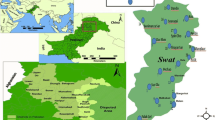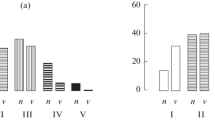Abstract
Stand growth and developmental processes were investigated in Pinus densiflora Siebold et Zucc. stands of different ages in the central eastern region of Korea. Stands were inventoried and five trees per stand were sampled for stem analysis, age estimation, and growth analysis. More than 80% of sampled trees in a stand were established within 3–5 years, and most stands had a single cohort structure. The initial growth of pine seedlings was slow, but the height growth accelerated beyond 2–3 m height, 5–10 years after establishment. Linear growth was maintained until 10–12 m height, at which suppressed trees fell behind and might die out. The young stand was composed of pure pines, while few pine seedlings and saplings were found in the understory of older stands. The peak of diameter growth rate occurred around 5–15 years after tree establishment, implying that competition begins during that period. The pine stand development follows four stages: (1) the young stage when the growth rate increases and peaks; (2) the height competition stage when trees focus on height growth for light while maintaining a narrow DBH and height distribution; (3) the differentiation stage when suppressed trees die out, and the DBH distribution becomes wider; and (4) the mature stage when stands have a multi-canopy structure with a wide DBH and height distribution, while the understory is dominated by other tree species. The changes in growth rates and stand structure through forest development would be implemented to predict alterations of above-ground carbon sequestration rates.





Similar content being viewed by others
References
Anderson KJ, Allen AP, Gollooly JF, Brown JH (2006) Temperature-dependence of biomass accumulation rates during secondary succession. Ecol Lett 9:673–682
Angara EV, Nakagoshi N, Nehira K (2000) Twenty-one years post-fire succession in a small watershed on Etajima Island, Hiroshima Prefecture, Southwestern Japan. J Int Dev Coop 6:177–196
Bae KH, Hong SC (1996) Structure and dynamics of Pinus densiflora community in Mt. Kaya. J Korean For Soc 85:260–270
Beon MS, Bartsch N (2003) Early seedling growth of pine (Pinus densiflora) and oaks (Quercus serrata, Q. mongolica, Q. variabilis) in response to light intensity and soil moisture. Plant Ecol 167:97–105
Byun JK, Kim YS, Yi MJ, Son Y, Kim C, Jeong JH, Lee CY, Jeong YH (2007) Growth response of Pinus densiflora, Larix leptolepis, Betula platyphylla var japonica and Quercus acutissima seedlings at various levels of fertilization. J Korean For Soc 96:693–698
Chun Y-M, Lee H-J, Lee C-S (2006) Vegetation trajectories of Korean red pine (Pinus densiflora Sieb et Zucc.) forests at Mt. Seorak, Korea. J Plant Biol 49:141–152
Chun HS, Kim JM, Choi EH, Chang N (2008) Neuroprotective effects of several Korean medicinal plants traditionally used for stroke remedy. J Med Food 11:246–251
Clements FE (1916) Plant succession: an analysis of the development of vegetation. Washington Publ. No. 242. Carnegie Institute, Washington, DC, pp 3–4
Curtis JT, McIntosh RP (1951) An upland forest continuum in the prairie-forest border region of Wisconsin. Ecology 32:476–496
Diochon A, Kellman L, Beltrami H (2009) Looking deeper: an investigation of soil carbon losses following harvesting from a managed northeastern red spruce (Picea rubens Sarg.) forest chronosequence. For Ecol Manage 257:413–420
Dupuy JM, Chazdon RL (2008) Interacting effects of canopy gap, understory vegetation and leaf litter on tree seedling recruitment and composition in tropical secondary forests. For Ecol Manage 255:3716–3725
Egler FE (1954) Vegetation science concepts I Initial floristic composition, a factor in old-field vegetation development. Vegetatio 4:412–417
Fielding AH (2007) Cluster and classification techniques for the biosciences. Cambridge University Press, New York
Finegan B (1984) Forest succession. Nature 312:109–114
Foster DR (1988) Species and stand response to catastrophic wind in Central New England, USA. J Ecol 76:135–151
Fujita K, Sano J (2000) Structure and developmental process of a Quercus mongolica var grosseserrata forest in the Fagetea crenatae region in Japan. Can J For Res 30:1877–1885
Husch B, Beers TW, Kershaw JA (2003) Forest mensuration, 4th edn. Wiley, New Jersey
Jeong JH, Koo KS, Lee CH, Kim CS (2002) Physio-chemical properties of Korean forest soils by regions. J Korean For Soc 91:694–700
Jo J (1994) Stand structure and growth pattern of Pinus densiflora S. et Z. and their relationship to forest fire in Sokwang-ri, Uljin-Gun. Dissertation, Seoul National University, Seoul
Kariuki M (2002) Height estimation in complete stem analysis using annual radial growth measurements. Forestry 75:63–74
Kato J, Hayashi I (2003) The determination and prediction of pine to oak forest succession in Sugadaira, Central Japan. Korean J Ecol 26:155–163
Kato J, Hayashi I (2006) Quantitative analysis of a stand of Pinus densiflora undergoing succession to Quercus mongolica ssp. crispula: 1. A 31-year record of growth and population dynamics of the canopy trees. Ecol Res 21:503–509
Kato J, Hayashi I (2007) Quantitative analysis of a stand of Pinus densiflora undergoing succession to Quercus mongolica ssp crispula: II. Growth and population dynamics of Q. mongolica ssp. crispula under the P. densiflora canopy. Ecol Res 22:527–533
Korea Forest Service (2009) Forestry statistics at a glance. Korea Forest Service, Daejeon
Korea Meteorological Administration (2009) Weather information. http://www.kma.go.kr/sfc/sfc_03_05.jsp. Accessed July 2009
Lee YN (1986) Korean Coniferae. Ewha Womans University Press, Seoul
Lee CH, Jin H-O, Kim YK (2001) Effects of Al and Mn on the growth, nutrient status and gas exchange rates of Pinus densiflora seedlings. J Korean For Soc 90:74–82
Liebsch D, Marques MCM, Goldenberg R (2008) How long does the Atlantic Rain Forest take to recover after a disturbance? Changes in species composition and ecological features during secondary succession. Biol Conserv 141:1717–1725
Lim J-H, Kim J-C, Kim K-J, Son YS, Sunwoo Y, Han J-S (2008) Seasonal variations of monoterpene emissions from Pinus densiflora in East Asia. Chemosphere 73:470–478
Nakai T (1911) Flora Koreana II. J Coll Sci Tokyo Imperial Univ 31:1–573
O’Keefe TC, Maiman RJ (2006) The influence of forest structure on riparian litterfall in a Pacific Coastal rain forest. Can J For Res 36:2852–2863
Okunomo K, Ogisi DO, Bosah BO (2009) Effect of growth media on germination and seedling growth of Persea americana (Mill.). J Food Agr Environ 7:111–113
Oliver CD, Larson BC (1996) Forest stand dynamics. Wiley, New York
Oliver CD, Stephens EP (1977) Reconstruction of a mixed-species forest in central New England. Ecology 58:562–572
Park PS, Lee DK (1996) Factors affecting the early natural regeneration of Pinus densiflora S et Z. after forest works at Mt. Joongwang located in Pyungchang-gun, Kangwon-do. J Korean For Soc 85:524–531
Pederson N, Varner JM III, Palik BJ (2008) Canopy disturbance and tree recruitment over two centuries in a managed longleaf pine landscape. For Ecol Manage 254:85–95
Piotto D (2008) A meta-analysis comparing tree growth in monocultures and mixed plantations. For Ecol Manage 255:781–786
Pitt DG, Morneault A, Parker WC, Stinson A, Lanteigne L (2008) The effects of erbaceous and woody competition on planted white pine in a clearcut site. For Ecol Manage 257:1281–1291
Taylor AH, Jinyan H, ShiQiang Z (2004) Canopy tree development and undergrowth bamboo dynamics in old-growth Abies–Betula forests in southwestern China: a 12-year study. For Ecol Manag 200:347–360
Turner PAM, Balmer J, Kirkpatrick JB (2009) Stand-replacing wildfires? The incidence of multi-cohort and single-cohort Eucalyptus regnans and E oblique forests in southern Tasmania. For Ecol Manage 258:366–375
Vasiliauskas S, Chen HYH (2002) How long do trees take to reach breast height after fire in northeastern Ontario? Can J For Res 32:1889–1892
Woo BM (2003) Achievements of the forest-tending works by national movement of the forest for life under the IMF structural adjustment program in Korea. J Korean For Soc 92:145–151
Xue L, Hagihara A (2008) Density effects on organs in self-thinning Pinus densiflora Sieb et Zucc. stands. Ecol Res 23:689–695
Youn Y-C (2009) Use of forest resources, traditional forest-related knowledge and livelihood of forest dependent communities: cases in South Korea. For Ecol Manage 257:2027–2034
Zar JH (1998) Biostatistical analysis, 4th edn. Prentice Hall, New York
Zhou J, Naito K, Takahashi Y (2003) Secondary vegetation and succession of abandoned grazed grassland in upland Southwest Honshu, Japan. Veg Sci 19:11–23
Zobel DB, Antos JA (1991) Growth and development of natural seedlings of Abies and Tsuga in old-growth forest. J Ecol 79:985–998
Acknowledgments
This research was supported by the Korea Forest Research Institute, and Korea Forest Service (Project No. S-110707L0101111 and 106105-3). We thank Jae Eun Sohng, Yun Mi Park, and Sun Kyung Lee for their assistance in laboratory data collection. Our thanks go to Drs. Don Koo Lee and Young Kwon Lee for their valuable comments. We are also thankful to the Southern Regional Forest Service of Korea Forest Service for their support in site selection and fieldwork. We acknowledge the Research Institute for Agriculture and Life Sciences, Seoul National University for grammar assistance.
Author information
Authors and Affiliations
Corresponding author
Rights and permissions
About this article
Cite this article
Park, P.S., Kim, K.Y., Han, A. et al. Development processes and growth pattern of Pinus densiflora stands in central eastern Korea. J Plant Res 123, 453–462 (2010). https://doi.org/10.1007/s10265-010-0351-4
Received:
Accepted:
Published:
Issue Date:
DOI: https://doi.org/10.1007/s10265-010-0351-4




